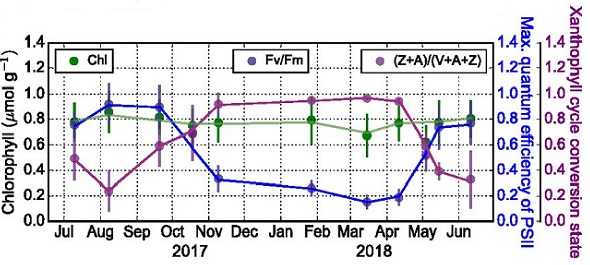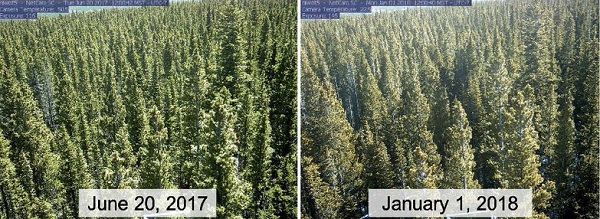Documentation Revision Date: 2019-11-21
Dataset Version: 1
Summary
There is one data file in comma-separated (.csv) format with this dataset.

Figure 1. Reported pigments Chlorophyll a+b concentration relative to dry mass (green) and dark-adapted xanthophyll cycle conversion state (purple) ([Zeaxanthin+Antheraxanthin]/ [Violaxanthin+Antheraxanthin+Zeaxanthin]) sampled at monthly intervals. All needleleaf measurements represent the mean and 1 SE of both Engelmann spruce and lodgepole pine samples during each 2- to 3-d sampling period. (Fv/Fm not described.) Figure from Magney et al. (2019).
Citation
Bowling, D.R., and B.A. Logan. 2019. Conifer Needle Pigment Composition, Niwot Ridge, Colorado, USA, 2017-2018. ORNL DAAC, Oak Ridge, Tennessee, USA. https://doi.org/10.3334/ORNLDAAC/1723
Table of Contents
- Dataset Overview
- Data Characteristics
- Application and Derivation
- Quality Assessment
- Data Acquisition, Materials, and Methods
- Data Access
- References
Dataset Overview
This dataset provides concentrations of pigments in pine and spruce needle tissues collected at the Niwot Ridge AmeriFlux Core site (US-NR1) near Nederland, Colorado, during the summers of 2017 and 2018. Pigments measured included Chlorophyll A and B, Violaxanthin, Antheraxanthin, Zeaxanthin, Neoxanthin, Lutein, and beta-Carotene. Measurements were made on sun foliage from two canopy-access towers near the main flux tower, and in the laboratory on branches collected from those towers, every 4-8 weeks over the annual cycle. Due to canopy structure, a limited number of trees were accessible from the towers, preventing extensive replication. Pigments were extracted in acetone and analyzed by HPLC. The measurements were made to evaluate seasonal changes associated with the down regulation of photosynthesis.
Project: Carbon Monitoring System (CMS)
The NASA Carbon Monitoring System (CMS) is designed to make significant contributions in characterizing, quantifying, understanding, and predicting the evolution of global carbon sources and sinks through improved monitoring of carbon stocks and fluxes. The System will use the full range of NASA satellite observations and modeling/analysis capabilities to establish the accuracy, quantitative uncertainties, and utility of products for supporting national and international policy, regulatory, and management activities. CMS will maintain a global emphasis while providing finer scale regional information, utilizing space-based and surface-based data and will rapidly initiate generation and distribution of products both for user evaluation and to inform near-term policy development and planning.
Related Publication:
Magney, T. S., D. R. Bowling, B.A. Logan, K. Grossmann, J. Stutz, P.D. Blanken, S.P. Burns, R. Cheng, M.A. Garcia, P. Kohler, S. Lopez, N.C. Parazoo, B. Raczka, D. Schimel, and C. Frankenberg. 2019. Mechanistic evidence for tracking the seasonality of photosynthesis with solar-induced fluorescence. Proceedings of the National Academy of Sciences 116:11640–11645. https://doi.org/10.1073/pnas.1900278116
Related Datasets: Leaf-level characteristics were measured at a conifer forest in Niwot Ridge, Colorado, including chlorophyll fluorescence (Bowling & Logan, 2019a) and needle pigment composition (this dataset). The leaf-level data was used in part to help define and validate parameters within an earth system model that was used to simulate leaf and canopy level fluorescence (Raczka et al., 2019).
Bowling, D.R., and B.A. Logan. 2019a. Conifer Needle Chlorophyll Fluorescence, Niwot Ridge, Colorado, USA, 2017-2018. ORNL DAAC, Oak Ridge, Tennessee, USA. https://doi.org/10.3334/ORNLDAAC/1722
Raczka, B.M., A. Porcar-Castell, T. Magney, J. Lee, P. Kohler, C. Frankenberg, K. Grossmann, B. Logan, J. Stutz, P.D. Blanken, S.P. Burns, H.F. Duarte, X. Yang, J.C. Lin, and D. Bowling. 2019. CLM Simulated Solar-Induced Fluorescence, Niwot Ridge, Colorado, USA, 1998-2018. ORNL DAAC, Oak Ridge, Tennessee, USA. https://doi.org/10.3334/ORNLDAAC/1720
Acknowledgements:
This study was supported by NASA’s Carbon Monitoring System Program, under grant NNX16AP33G
Data Characteristics
Spatial Coverage: Niwot Ridge, CO, AmeriFlux Core Site US-NR1
Spatial Resolution: Point
Temporal Coverage: 2017-07-09 to 2018-06-11
Temporal Resolution: Approximately monthly
Study Area: (all latitudes and longitudes given in decimal degrees)
|
Site |
Westernmost Longitude |
Easternmost Longitude |
Northernmost Latitude |
Southernmost Latitude |
|---|---|---|---|---|
|
Niwot Ridge, CO, AmeriFlux Core Site US-NR1 |
-105.55 |
-105.55 |
40.03 |
40.03 |
Data File Information
There is one data file in comma-separated format with this dataset: NiwotRidge_coniferneedle_pigments_2017_2018.csv. This file provides pigment concentrations in needle tissue from conifers samples at the Niwot Ridge Ameriflux Tower site US-NR1 in 2017 and 2018.
Table 1. Variables in the data file
| Variable | Units | Description |
|---|---|---|
| sample_id |
Sample ID: YYMMDD Xn Bn Rn D or L (Examples: 170710 P2B1R1 and 180314S3B2R1D) Where: YYMMDD = date of sampling Xn = tree species and tree number
Bn = branch number (multiple branches were sampled on the same tree) Rn = replicate number (same branch and date). Replicates at different needle illumination levels. D or L = D (dark) or L (light) treatment. See Treatment below. Extra samples were collected on a few sampling dates, indicated with EXn (preceding the D or L) |
|
| sample_date | YYYY-MM-DD | Sampling date |
| latitude | Decimal degrees | Latitude of the Niwot Ridge AmeriFlux site study area |
| longitude | Decimal degrees | Longitude of the Niwot Ridge AmeriFlux site study area |
| treatment | D (dark) or L (light) | |
| tree_species | Pine or Spruce | |
| chlorophyll_B | µmol/g | Chlorophyll B concentration, moles per unit fresh mass |
| chlorophyll_A | µmol/g | Chlorophyll A concentration, moles per unit fresh mass |
| chlorophyll_pool | µmol/g | Chlorophyll pool (Chlorophyll B + Chlorophyll A) concentration, moles per unit fresh mass |
| violaxanthin | µmol/g | Violaxanthin concentration, moles per unit fresh mass |
| neoxanthin | µmol/g | Neoxanthin concentration, moles per unit fresh mass |
| antheraxanthin | µmol/g | Antheraxanthin concentration, moles per unit fresh mass |
| lutein | µmol/g | Lutein concentration, moles per unit fresh mass |
| zeaxanthin | µmol/g | Zeaxanthin concentration, moles per unit fresh mass |
| beta_carotene | µmol/g | Beta Carotene concentration, moles per unit fresh mass |
Application and Derivation
The study could be useful to climate change studies and the estimation of gross primary production (GPP) particularly when combined with SIF and fluorescence data from the related datasets listed in Section 2 of this guide. Accurately determining the timing of seasonal GPP onset and cessation in evergreen forests is difficult. The data from this study indicates that the needles retained chlorophyll year-round despite cold temperatures and high light in winter.
Quality Assessment
Due to canopy structure, a limited number of trees were accessible from the towers, preventing more extensive replication. This also limited sampling to P. contorta ad P. engelmannii needles. Species were pooled together to better match the FOV of tower- and satellite-based SIF retrievals (related dataset); however, no significant difference was observed between the two species at any time during the season (Magney et al., 2019).
Data Acquisition, Materials, and Methods
The research was conducted at a high-elevation conifer forest in Colorado, USA (the Niwot Ridge AmeriFlux Core Site US-NR1, 40.03°N, 105.55°W, 3,050 m elevation), over the annual period from summer 2017 to summer 2018. The forest is composed of three dominant evergreen needleleaf species: lodgepole pine (Pinus contorta Douglas ex Loudon), Engelmann spruce (Picea engelmannii Parry ex Engelm.), and subalpine fir (Abies lasiocarpa (Hook.) Nutt.). The climate includes cold winters with a persistent snowpack from October-November to May-June.

Figure 2. Phenocam (webcam) images of the canopy at Niwot Ridge, CO where the data were collected during different seasons (Magney et al., 2019).
Experimental Design
To determine seasonality of photosynthetic performance at the needle level, physiological measurements were made on sun foliage from two canopy-access towers near the main flux tower, and in the laboratory on branches collected from those towers, every 4-8 weeks over the annual cycle. These included chlorophyll fluorescence (refer to the related dataset in the Overview Section of this document) and needle pigment composition for pine and spruce trees. Due to canopy structure, a limited number of trees were accessible from the towers, preventing extensive replication. Two branches were measured/sampled from each tree on each visit (n=6 branches on 3 trees for pine, and n=4 branches on 2 trees for spruce, in the upper canopy at 10-12 m height above ground).
Chlorophyll A and B, Violaxanthin, Antheraxanthin, Zeaxanthin, Neoxanthin, Lutein, and β-Carotene pigments in needle tissue were measured to evaluate seasonal changes associated with the down regulation of photosynthesis. Needles were stored frozen in LN2, dry ice, or a -80 °C freezer until analysis. Pigments were extracted in solvent and analyzed by liquid chromatography as described in Bowling et al. (2018). Needle pigment contents are expressed as moles per unit fresh mass and as molar ratios (chlorophyll a/b and total chlorophyll/total carotenoid) (Magney et al., 2019).
Data Access
These data are available through the Oak Ridge National Laboratory (ORNL) Distributed Active Archive Center (DAAC).
Conifer Needle Pigment Composition, Niwot Ridge, Colorado, USA, 2017-2018
Contact for Data Center Access Information:
- E-mail: uso@daac.ornl.gov
- Telephone: +1 (865) 241-3952
References
Bowling, D.R., B.A. Logan, K. Hufkens, D.M. Aubrecht, A.D. Richardson, S.P. Burns, W.R.L. Anderegg, P.D. Blanken, and D.P. Eriksson. 2018. Limitations to winter and spring photosynthesis of a Rocky Mountain subalpine forest. Agricultural and Forest Meteorology, (252),15, pgs. 241-255. https://doi.org/10.1016/j.agrformet.2018.01.025
Magney, T. S., D.R. Bowling, B.A. Logan, K. Grossmann, J. Stutz, P.D. Blanken, S.P. Burns, R. Cheng, M.A. Garcia, P. Kohler, S. Lopez, N.C. Parazoo, B. Raczka, D. Schimel, and C. Frankenberg. 2019. Mechanistic evidence for tracking the seasonality of photosynthesis with solar-induced fluorescence. Proceedings of the National Academy of Sciences 116:11640–11645. https://doi.org/10.1073/pnas.1900278116